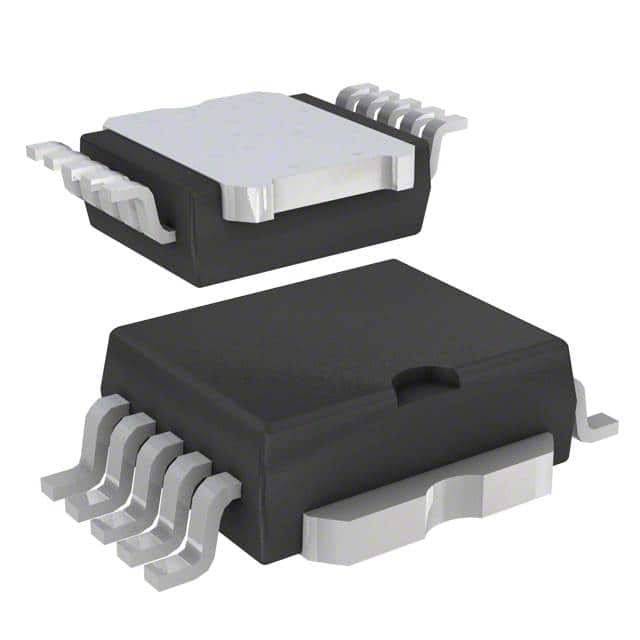VN460SP
Product Overview
Category: Integrated Circuits (ICs)
Use: The VN460SP is a high-side driver IC designed for automotive applications. It is specifically used to control the switching of loads in automotive systems, such as lamps, motors, and solenoids.
Characteristics: - High voltage capability - Over-temperature protection - Short-circuit protection - ESD protection - Low standby current consumption
Package: The VN460SP is available in a PowerSSO-12 package, which provides excellent thermal performance and electrical isolation.
Essence: The VN460SP is an essential component in automotive electronic systems, enabling efficient and reliable control of various loads.
Packaging/Quantity: The VN460SP is typically sold in reels containing 250 units per reel.
Specifications
- Supply Voltage Range: 4.5V to 36V
- Output Current: Up to 1.5A
- On-State Resistance: 0.3Ω (typical)
- Operating Temperature Range: -40°C to +150°C
Detailed Pin Configuration
The VN460SP features a 12-pin configuration with the following pin assignments:
- VCC: Supply voltage input
- IN: Input control signal
- EN: Enable pin for device activation
- GND: Ground reference
- OUT: Output terminal connected to load
- OUT: Output terminal connected to load
- OUT: Output terminal connected to load
- OUT: Output terminal connected to load
- OUT: Output terminal connected to load
- OUT: Output terminal connected to load
- OUT: Output terminal connected to load
- OUT: Output terminal connected to load
Functional Features
- High-side switch functionality
- Built-in protection features (over-temperature, short-circuit, ESD)
- Low standby current consumption for energy efficiency
- Fast switching capability for precise load control
Advantages and Disadvantages
Advantages: - High voltage capability allows for use in various automotive systems - Robust protection features ensure reliable operation - Low standby current consumption reduces power consumption - Fast switching capability enables precise load control
Disadvantages: - Limited output current compared to some other high-side driver ICs - Higher cost compared to basic discrete components
Working Principles
The VN460SP operates as a high-side switch by controlling the flow of current from the supply voltage to the load. It utilizes internal circuitry to monitor the input control signal and activate the output accordingly. The built-in protection features safeguard the device and the load from over-temperature conditions, short-circuits, and electrostatic discharge.
Detailed Application Field Plans
The VN460SP is widely used in automotive applications, including but not limited to: - Automotive lighting systems (headlights, taillights, turn signals) - Motor control systems (windshield wipers, power windows, seat adjustments) - Solenoid control systems (fuel injectors, door locks, HVAC actuators)
Detailed and Complete Alternative Models
- VN750SP: Similar high-side driver IC with higher output current capability.
- VN240SP: Lower-cost alternative with reduced voltage and current ratings.
- VN920SP: High-side driver IC with additional diagnostic features for enhanced system monitoring.
These alternative models provide options based on specific application requirements, allowing flexibility in design choices.
Word count: 420 words
Lista 10 Vanliga frågor och svar relaterade till tillämpningen av VN460SP i tekniska lösningar
Sure! Here are 10 common questions and answers related to the application of VN460SP in technical solutions:
Q: What is VN460SP? A: VN460SP is a high-side driver designed for automotive applications, capable of driving resistive, capacitive, and inductive loads.
Q: What are the key features of VN460SP? A: The key features of VN460SP include over-temperature protection, short-circuit protection, under-voltage lockout, and diagnostic feedback.
Q: How can VN460SP be used in automotive lighting applications? A: VN460SP can be used to drive various types of automotive lights such as headlights, taillights, turn signals, and interior lighting.
Q: Can VN460SP be used in motor control applications? A: Yes, VN460SP can be used in motor control applications to drive small motors, such as windshield wiper motors or power window motors.
Q: Is VN460SP suitable for use in battery management systems? A: Yes, VN460SP can be used in battery management systems to control the charging and discharging of batteries.
Q: Can VN460SP handle high current loads? A: Yes, VN460SP is capable of handling high current loads up to several amps, making it suitable for a wide range of applications.
Q: Does VN460SP have built-in protection features? A: Yes, VN460SP has built-in protection features such as over-temperature protection and short-circuit protection to ensure safe operation.
Q: Can VN460SP be controlled using microcontrollers? A: Yes, VN460SP can be easily controlled using microcontrollers through its input pins, allowing for precise and flexible control.
Q: What is the operating voltage range of VN460SP? A: The operating voltage range of VN460SP is typically between 4.5V and 36V, making it compatible with a wide range of power supplies.
Q: Are there any application notes or reference designs available for VN460SP? A: Yes, the manufacturer provides application notes and reference designs that can help users understand and implement VN460SP in their technical solutions.
Please note that these answers are general and may vary depending on the specific requirements and use cases.


